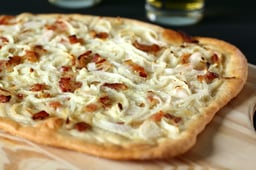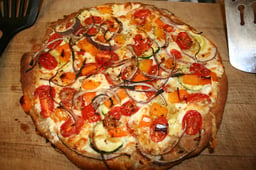Pizza

Pizza

Pizza (Italian: [ˈpittsa], Neapolitan: [ˈpittsə]) is a savory dish of Italian origin, consisting of a usually round, flattened base of leavened wheat-based dough topped with tomatoes, cheese, and various other ingredients (anchovies, olives, meat, etc.) baked at a high temperature, traditionally in a wood-fired oven.[1] A small pizza is sometimes called a pizzetta.
The term pizza was first recorded in the 10th century in a Latin manuscript from the Southern Italian town of Gaeta in Lazio, on the border with Campania.[4] Modern pizza was invented in Naples, and the dish and its variants have since become popular in many countries.[5] It has become one of the most popular foods in the world and a common fast food item in Europe and North America, available at pizzerias (restaurants specializing in pizza), restaurants offering Mediterranean cuisine, and via pizza delivery.[5][6] Many companies sell ready-baked frozen pizzas to be reheated in an ordinary home oven.
The Associazione Verace Pizza Napoletana (lit. True Neapolitan Pizza Association) is a non-profit organization founded in 1984 with headquarters in Naples that aims to promote traditional Neapolitan pizza.[7] In 2009, upon Italy's request, Neapolitan pizza was registered with the European Union as a Traditional Speciality Guaranteed dish,[8][9] and in 2017 the art of its making was included on UNESCO's list of intangible cultural heritage.[10]
Etymology

Pizza with cheese and toppings, cut into slices
The word "pizza" first appeared in a Latin text from the central Italian town of Gaeta, then still part of the Byzantine Empire, in 997 AD; the text states that a tenant of certain property is to give the bishop of Gaeta duodecim pizze ("twelve pizzas") every Christmas Day, and another twelve every Easter Sunday.[4][11]
Suggested etymologies include:
Byzantine Greek and Late Latin pitta > pizza, cf. Modern Greek pitta bread and the Apulia and Calabrian (then Byzantine Italy) pitta, [12] a round flat bread baked in the oven at high temperature sometimes with toppings. The word pitta can in turn be traced to either Ancient Greek πικτή (pikte), "fermented pastry", which in Latin became "picta", or Ancient Greek πίσσα (pissa, Attic πίττα, pitta), "pitch",[13][14] or pḗtea, "bran" (pētítēs, "bran bread").[15]
The Etymological Dictionary of the Italian Language explains it as coming from dialectal pinza "clamp", as in modern Italian pinze "pliers, pincers, tongs, forceps". Their origin is from Latin pinsere "to pound, stamp".[16]
The Lombardic word bizzo or pizzo meaning "mouthful" (related to the English words "bit" and "bite"), which was brought to Italy in the middle of the 6th century AD by the invading Lombards.[4][17]
History

A pizzaiolo in 1830

Antica Pizzeria Port'Alba in Naples
Foods similar to pizza have been made since the Neolithic Age.[18] Records of people adding other ingredients to bread to make it more flavorful can be found throughout ancient history. In the 6th century BC, the Persian soldiers of Achaemenid Empire during the rule King Darius I baked flatbreads with cheese and dates on top of their battle shields[19][20] and the ancient Greeks supplemented their bread with oils, herbs, and cheese.[21][22] An early reference to a pizza-like food occurs in the Aeneid, when Celaeno, queen of the Harpies, foretells that the Trojans would not find peace until they are forced by hunger to eat their tables (Book III). In Book VII, Aeneas and his men are served a meal that includes round cakes (like pita bread) topped with cooked vegetables. When they eat the bread, they realize that these are the "tables" prophesied by Celaeno.[23]
Modern pizza evolved from similar flatbread dishes in Naples, Italy, in the 18th or early 19th century.[24] Prior to that time, flatbread was often topped with ingredients such as garlic, salt, lard, cheese, and basil. It is uncertain when tomatoes were first added and there are many conflicting claims.[24]
A popular contemporary legend holds that the archetypal pizza, pizza Margherita, was invented in 1889, when the Royal Palace of Capodimonte commissioned the Neapolitan pizzaiolo (pizza maker) Raffaele Esposito to create a pizza in honor of the visiting Queen Margherita. Of the three different pizzas he created, the Queen strongly preferred a pizza swathed in the colors of the Italian flag — red (tomato), green (basil), and white (mozzarella). Supposedly, this kind of pizza was then named after the Queen,[25] although later research cast doubt on this legend.[26] An official letter of recognition from the Queen's "head of service" remains on display in Esposito's shop, now called the Pizzeria Brandi.[27]
Pizza was brought to the United States with Italian immigrants in the late nineteenth century[24] and first appeared in areas where Italian immigrants concentrated. The country's first pizzeria, Lombardi's, opened in 1905.[29] Following World War II, veterans returning from the Italian Campaign, who were introduced to Italy's native cuisine proved a ready market for pizza in particular.[30]
Preparation
Pizza is sold fresh, frozen, and as portion-size slices or pieces. Methods have been developed to overcome challenges such as preventing the sauce from combining with the dough and producing a crust that can be frozen and reheated without becoming rigid. There are frozen pizzas with raw ingredients and self-rising crusts.
Another form of uncooked pizza is available from take and bake pizzerias. This pizza is assembled in the store, then sold to customers to bake in their own ovens. Some grocery stores sell fresh dough along with sauce and basic ingredients, to complete at home before baking in an oven.
Cooking
In restaurants, pizza can be baked in an oven with stone bricks above the heat source, an electric deck oven, a conveyor belt oven or, in the case of more expensive restaurants, a wood or coal-fired brick oven. On deck ovens, pizza can be slid into the oven on a long paddle, called a peel, and baked directly on the hot bricks or baked on a screen (a round metal grate, typically aluminum). Prior to use, a peel may be sprinkled with cornmeal to allow pizza to easily slide onto and off of it.[31] When made at home, it can be baked on a pizza stone in a regular oven to reproduce the effect of a brick oven. Cooking directly in a metal oven results in too rapid heat transfer to the crust, burning it.[32] Aficionado home-chefs sometimes use a specialty wood-fired pizza oven, usually installed outdoors. Dome-shaped pizza ovens have been used for centuries,[33] which is one way to achieve true heat distribution in a wood-fired pizza oven. Another option is grilled pizza, in which the crust is baked directly on a barbecue grill. Greek pizza, like Chicago-style pizza, is baked in a pan rather than directly on the bricks of the pizza oven.
When it comes to preparation, the dough and ingredients can be combined on any kind of table.
With mass production of pizza, the process can be completely automated. Most restaurants still use standard and purpose-built pizza preparation tables. Pizzerias nowadays can even opt for hi tech pizza preparation tables that combine mass production elements with traditional techniques.[34]
Crust

A pizza just removed from an oven, with a close-up view of the cornicione (the outer edge)
The bottom of the pizza, called the "crust", may vary widely according to style, thin as in a typical hand-tossed Neapolitan pizza or thick as in a deep-dish Chicago-style. It is traditionally plain, but may also be seasoned with garlic or herbs, or stuffed with cheese. The outer edge of the pizza is sometimes referred to as the cornicione.[35] Pizza dough often contains sugar, both to help its yeast rise and enhance browning of the crust.[36]
Dipping sauce specifically for pizza was invented by American pizza chain Papa John's Pizza in 1984 and has since become popular when eating pizza, especially the crust.[37]
Cheese
![A pizza quattro formaggi (Italian: [ˈkwattro forˈmaddʒi], "four cheeses") in London](https://everipedia.org/cdn-cgi/image/width=640/https://upload.wikimedia.org/wikipedia/commons/a/ad/Pizza_quattro_formaggi_at_restaurant%2C_Chalk_Farm_Road%2C_London.jpg)
A pizza quattro formaggi (Italian: [ˈkwattro forˈmaddʒi], "four cheeses") in London
Mozzarella is commonly used on pizza, with the highest quality buffalo mozzarella produced in the surroundings of Naples.[38] Eventually, other cheeses were used well as pizza ingredients, particularly Italian cheeses including provolone, pecorino romano, ricotta, and scamorza. Less expensive processed cheeses or cheese analogues have been developed for mass-market pizzas to produce desirable qualities like browning, melting, stretchiness, consistent fat and moisture content, and stable shelf life. This quest to create the ideal and economical pizza cheese has involved many studies and experiments analyzing the impact of vegetable oil, manufacturing and culture processes, denatured whey proteins and other changes in manufacture. In 1997 it was estimated that annual production of pizza cheese was 1 million tonnes (1,100,000 short tons) in the U.S. and 100,000 tonnes (110,000 short tons) in Europe.[39]
Varieties
Italy

Spinach pizza, Turin
Authentic Neapolitan pizza (pizza napoletana) is made with San Marzano tomatoes, grown on the volcanic plains south of Mount Vesuvius, and mozzarella di bufala Campana, made with milk from water buffalo raised in the marshlands of Campania and Lazio.[40] This mozzarella is protected with its own European protected designation of origin.[40] Other traditional pizzas include pizza alla marinara, which is topped with marinara sauce and is supposedly the most ancient tomato-topped pizza,[41] pizza capricciosa, which is prepared with mozzarella cheese, baked ham, mushroom, artichoke and tomato,[42] and pizza pugliese, prepared with tomato, mozzarella and onions.[43]
A popular variant of pizza in Italy is Sicilian pizza (locally called sfincione or sfinciuni),[44][45] a thick-crust or deep-dish pizza originating during the 17th century in Sicily: it is essentially a focaccia that is typically topped with tomato sauce and other ingredients. Until the 1860s, sfincione was the type of pizza usually consumed in Sicily, especially in the Western portion of the island.[46] Other variations of pizzas are also found in other regions of Italy, for example pizza al padellino or pizza al tegamino, a small-sized, thick-crust and deep-dish pizza typically served in Turin, Piedmont.[47][48][49]
United States

Pizza banquet in the White House
13% of the United States population consumes pizza on any given day.[50] Pizza chains such as Domino's Pizza, Pizza Hut, and Papa John's, pizzas from take and bake pizzerias, and chilled or frozen pizzas from supermarkets make pizza readily available nationwide.
Common toppings for pizza in the United States include ground beef, mushrooms, onions, pepperoni, pineapple, garlic, olives, peppers, carrots, tomatoes, spinach, anchovies, chicken, bacon, ham and sausage. Distinct regional types developed in the 20th century, including California, Chicago, Detroit, Greek, New Haven, New York and St. Louis styles.[51] The first pizzeria in the U.S. was opened in New York's Little Italy in 1905[52] and since then regions throughout the U.S. offer variations, including deep-dish, stuffed, pockets, turnovers, rolled and pizza-on-a-stick, each with seemingly limitless combinations of sauce and toppings.
Another variation is grilled pizza, created by taking a fairly thin, round (more typically, irregularly shaped) sheet of yeasted pizza dough, placing it directly over the fire of a grill and then turning it over once the bottom has baked and placing a thin layer of toppings on the baked side.[53] Toppings may be sliced thin to ensure that they heat through, and chunkier toppings such as sausage or peppers may be precooked before being placed on the pizza.[54] Garlic, herbs, or other ingredients are sometimes added to the pizza or the crust to maximize the flavor of the dish.[55]
Grilled pizza was offered in the United States at the Al Forno restaurant in Providence, Rhode Island[56] by owners Johanne Killeen and George Germon in 1980. Although it was inspired by a misunderstanding that confused a wood-fired brick oven with a grill, grilled pizza did exist prior to 1980, both in Italy, and in Argentina where it is known as pizza a la parrilla.[57] It has become a popular cookout dish, and there are even some pizza restaurants that specialize in the style. The traditional style of grilled pizza employed at Al Forno restaurant uses a dough coated with olive oil,[56] strained tomato sauce, thin slices of fresh mozzarella, and a garnish made from shaved scallions, and is served uncut.[58] The final product can be likened to flatbread with pizza toppings.[56] Another Providence establishment, Bob & Timmy's Grilled Pizza, was featured in a Providence-themed episode of the Travel Channel's Man v. Food Nation in 2011.[59]
Argentina
Argentina, and more specifically Buenos Aires, received a massive Italian immigration at the turn of the 19th century. Immigrants from Naples and Genoa opened the first pizza bars, though over time Spanish residents came to own the majority of the pizza businesses.
Standard Argentine pizza has a thicker crust, called "media masa" (half dough) than traditional Italian style pizza and includes more cheese. Argentine gastronomy tradition, served pizza with fainá, which is a Genovese chick pea-flour dough placed over the piece of pizza, and moscato wine. The most popular variety of pizza is called "muzzarella" (mozzarella), similar to Neapolitan pizza (bread, tomato sauce and cheese) but made with a thicker "media masa" crust, triple cheese and tomato sauce, usually also with olives. It can be found in nearly every corner of the country; Buenos Aires is considered the city with the most pizza bars by person of the world.[60] Other popular varieties include jam, tomato slices, red pepper and longaniza. Two Argentine-born varieties of pizza with onion, are also very popular: fugazza with cheese and fugazzetta. The former one consists in a regular pizza crust topped with cheese and onions; the later has the cheese between two pizza crusts, with onions on top.[61][62]
Records

Pizza-eating contest
The world's largest pizza was prepared in Rome in December 2012, and measured 1,261 square meters (13,570 square feet).
The pizza was named "Ottavia" in homage to the first Roman emperor Octavian Augustus, and was made with a gluten-free base.[63] The world's longest pizza was made in Fontana, California in 2017 and measured 1,930.39 meters (6,333.3 feet).[64]
The world's most expensive pizza listed by Guinness World Records is a commercially available thin-crust pizza at Maze restaurant in London, United Kingdom, which costs GB£ 100. The pizza is wood fire-baked, and is topped with onion puree, white truffle paste, fontina cheese, baby mozzarella, pancetta, cep mushrooms, freshly picked wild mizuna lettuce, and fresh shavings of a rare Italian white truffle.[65]
There are several instances of more expensive pizzas, such as the GB£ 4,200 "Pizza Royale 007" at Haggis restaurant in Glasgow, Scotland, which has caviar, lobster and is topped with 24-carat gold dust, and the US$1,000 caviar pizza made by Nino's Bellissima pizzeria in New York City, New York.[66][67] However, these are not officially recognized by Guinness World Records. Additionally, a pizza was made by the restaurateur Domenico Crolla that included toppings such as sunblush-tomato sauce, Scottish smoked salmon, medallions of venison, edible gold, lobster marinated in cognac, and champagne-soaked caviar. The pizza was auctioned for charity in 2007, raising GB£ 2,150.[68]
Health concerns
Some mass-produced pizzas by fast food chains have been criticized as having an unhealthy balance of ingredients. Pizza can be high in salt, fat and calories (food energy). The USDA reports an average sodium content of 5,101 mg per 14 in (36 cm) pizza in fast food chains.[71] There are concerns about negative health effects.[72] Food chains have come under criticism at various times for the high salt content of some of their meals.[73]
Frequent pizza eaters in Italy have been found to have a relatively low incidence of cardiovascular disease[74] and digestive tract cancers[75] relative to infrequent pizza eaters, although the nature of the association between pizza and such perceived benefits is unclear. Pizza consumption in Italy might only indicate adherence to traditional Mediterranean dietary patterns, which have been shown to have various health benefits.[75]
National Pizza Month
National Pizza Month is an annual observance that occurs for the month of October in the United States and some areas of Canada.[78][79][80][81] This observance began in October 1984, and was created by Gerry Durnell, the publisher of Pizza Today magazine.[81] During this time, some people observe National Pizza Month by consuming various types of pizzas or pizza slices, or going to various pizzerias.[78]
Similar dishes
Calzone and stromboli are similar dishes (a calzone is a pizza folded into a half-moon-shape; a stromboli is tube-shaped) that are often made of pizza dough rolled or folded around a filling.
Panzerotti are similar to calzones, but fried rather than baked.
"Farinata" or "cecina".[82] A Ligurian (farinata) and Tuscan (cecina) regional dish made from chickpea flour, water, salt and olive oil. Also called socca in the Provence region of France. Often baked in a brick oven, and typically weighed and sold by the slice.
The Alsatian Flammekueche[83] (Standard German: Flammkuchen, French: Tarte flambée) is a thin disc of dough covered in crème fraîche, onions, and bacon.
Garlic fingers is an Atlantic Canadian dish, similar to a pizza in shape and size, and made with similar dough. It is garnished with melted butter, garlic, cheese, and sometimes bacon.
The Anatolian Lahmajoun (Arabic: laḥm bi'ajīn; Armenian: lahmajoun; also Armenian pizza or Turkish pizza) is a meat-topped dough round. The base is very thin, and the layer of meat often includes chopped vegetables.[84]
The Levantine Manakish (Arabic: ma'ujnāt) and Sfiha (Arabic: laḥm bi'ajīn; also Arab pizza) are dishes similar to pizza.
The Macedonian Pastrmajlija
The Provençal Pissaladière is similar to an Italian pizza, with a slightly thicker crust and a topping of cooked onions, anchovies, and olives.
Pizza bagel is a bagel with toppings similar to that of traditional pizzas.
Pizza bread is a type of sandwich that is often served open-faced which consists of bread, tomato sauce, cheese[85] and various toppings.
Homemade versions may be prepared.
Pizza sticks may be prepared with pizza dough and pizza ingredients, in which the dough is shaped into stick forms, sauce and toppings are added, and it is then baked.[86] Bread dough may also be used in their preparation,[87] and some versions are fried.[88]
Pizza Rolls are a trade-marked commercial product.
Okonomiyaki, a Japanese dish cooked on a hotplate, is often referred to as "Japanese pizza".[89]
"Zanzibar pizza" is a street food served in Stone Town, Zanzibar, Tanzania. It uses a dough much thinner than pizza dough, almost like filo dough, filled with minced beef, onions, and an egg, similar to Moroccan bestila.[90]
Panizza is half a stick of bread (often baguette), topped with the usual pizza ingredients, baked in an oven.















